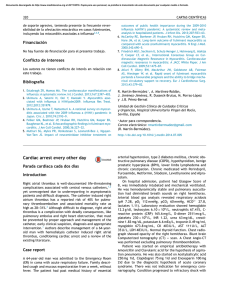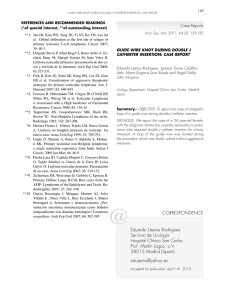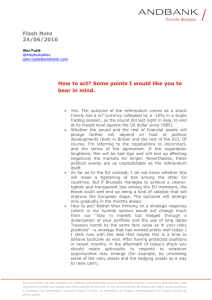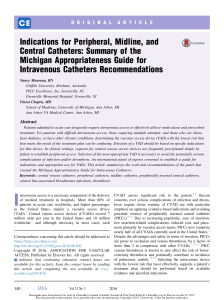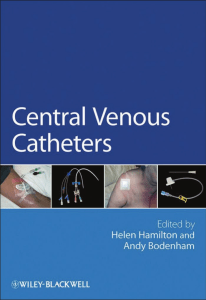Have we forgotten the most important thing to prevent bacteremias
Anuncio
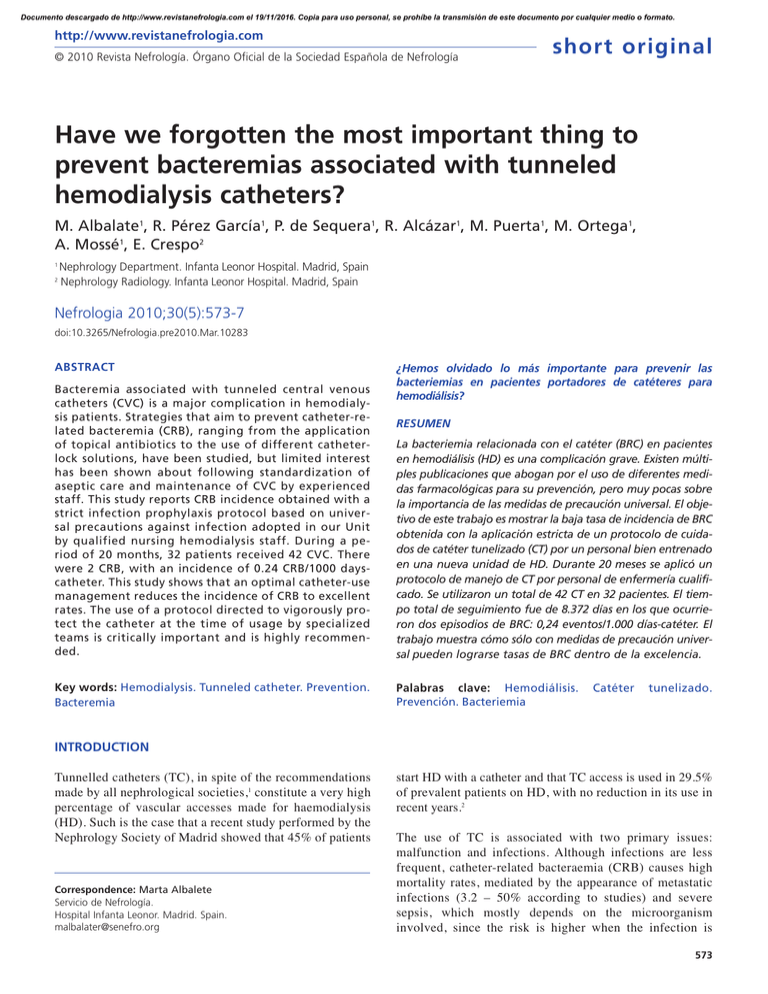
Documento descargado de http://www.revistanefrologia.com el 19/11/2016. Copia para uso personal, se prohíbe la transmisión de este documento por cualquier medio o formato. http://www.revistanefrologia.com © 2010 Revista Nefrología. Órgano Oficial de la Sociedad Española de Nefrología short original Have we forgotten the most important thing to prevent bacteremias associated with tunneled hemodialysis catheters? M. Albalate1, R. Pérez García1, P. de Sequera1, R. Alcázar1, M. Puerta1, M. Ortega1, A. Mossé1, E. Crespo2 1 2 Nephrology Department. Infanta Leonor Hospital. Madrid, Spain Nephrology Radiology. Infanta Leonor Hospital. Madrid, Spain Nefrologia 2010;30(5):573-7 doi:10.3265/Nefrologia.pre2010.Mar.10283 ABSTRACT Bacteremia associated with tunneled central venous catheters (CVC) is a major complication in hemodialysis patients. Strategies that aim to prevent catheter-related bacteremia (CRB), ranging from the application of topical antibiotics to the use of different catheterlock solutions, have been studied, but limited interest has been shown about following standardization of aseptic care and maintenance of CVC by experienced staff. This study reports CRB incidence obtained with a strict infection prophylaxis protocol based on universal precautions against infection adopted in our Unit by qualified nursing hemodialysis staff. During a period of 20 months, 32 patients received 42 CVC. There were 2 CRB, with an incidence of 0.24 CRB/1000 dayscatheter. This study shows that an optimal catheter-use management reduces the incidence of CRB to excellent rates. The use of a protocol directed to vigorously protect the catheter at the time of usage by specialized teams is critically important and is highly recommended. Key words: Hemodialysis. Tunneled catheter. Prevention. Bacteremia ¿Hemos olvidado lo más importante para prevenir las bacteriemias en pacientes portadores de catéteres para hemodiálisis? RESUMEN La bacteriemia relacionada con el catéter (BRC) en pacientes en hemodiálisis (HD) es una complicación grave. Existen múltiples publicaciones que abogan por el uso de diferentes medidas farmacológicas para su prevención, pero muy pocas sobre la importancia de las medidas de precaución universal. El objetivo de este trabajo es mostrar la baja tasa de incidencia de BRC obtenida con la aplicación estricta de un protocolo de cuidados de catéter tunelizado (CT) por un personal bien entrenado en una nueva unidad de HD. Durante 20 meses se aplicó un protocolo de manejo de CT por personal de enfermería cualificado. Se utilizaron un total de 42 CT en 32 pacientes. El tiempo total de seguimiento fue de 8.372 días en los que ocurrieron dos episodios de BRC: 0,24 eventos/1.000 días-catéter. El trabajo muestra cómo sólo con medidas de precaución universal pueden lograrse tasas de BRC dentro de la excelencia. Palabras clave: Hemodiálisis. Prevención. Bacteriemia Catéter tunelizado. INTRODUCTION Tunnelled catheters (TC), in spite of the recommendations made by all nephrological societies,1 constitute a very high percentage of vascular accesses made for haemodialysis (HD). Such is the case that a recent study performed by the Nephrology Society of Madrid showed that 45% of patients Correspondence: Marta Albalete Servicio de Nefrología. Hospital Infanta Leonor. Madrid. Spain. [email protected] start HD with a catheter and that TC access is used in 29.5% of prevalent patients on HD, with no reduction in its use in recent years.2 The use of TC is associated with two primary issues: malfunction and infections. Although infections are less frequent, catheter-related bacteraemia (CRB) causes high mortality rates, mediated by the appearance of metastatic infections (3.2 – 50% according to studies) and severe sepsis, which mostly depends on the microorganism involved, since the risk is higher when the infection is 573 Documento descargado de http://www.revistanefrologia.com el 19/11/2016. Copia para uso personal, se prohíbe la transmisión de este documento por cualquier medio o formato. short original caused by S. aureus. We cannot forget that infections are the second highest cause of death in HD.3 The published frequency of CRB is variable and oscillates between 0.74 and 9.15 events/1,000 catheter-days. This wide range reflects the important differences that exist in clinical practices. According to Beathard and Urbanes,6 a centre that has a rate greater than 2 events/1,000 catheter-days must reassess its preventative practices (Table 1). In the majority of medical articles published in recent years, these practices are based on pharmacological measures, forgetting the fundamental aspect of aseptic management of TC in all manipulations by the nursing staff. Rates as low as 1/1,000 catheter-days have been published using only aseptic methods,7 demonstrating that a correct and rigorous management of TC can avoid CRB without exposing patients to possible secondary effects from a pharmacological treatment. TC infections can be produced upon insertion (an aspect that we cannot control in the dialysis unit) or later during its normal use. The ports of entry for infection are the punctured skin and venous/arterial connections. Antiseptics and antibiotics applied to the point of entry appear to be useful measures for reducing the number of CRB by preventing infection at the point of entry into the skin.8 It is currently recommended to clean the skin at the TC point of entry before each HD session with 2% chlorhexidine in place of povidone, which takes longer to take effect. However, the key is in the care of the i.v. connection point, since this is the main point of entry for pathogens.9 Contamination here provokes colonization of the internal surface of the catheter, forming a biofilm. This contamination can be produced when: 1) the i.v. connection and dialysis line are not properly cleaned before connection; 2) the connection touches unsterile surfaces or is exposed to the air during a prolonged period of time, or 3) nursing staff or the patient breaths upon the connection point without a facemask. M. Albalate et al. Prevention of CRB in HD with aseptic management of TC,8,10,11 although long-term effects (such as bacterial resistance and ototoxicity12 according to the drug used) are unknown.13 Non-antibiotic substances have also been used for catheter priming, such as citrate, with uneven results,4, 14 taurolidine,15,16 a combination of citrate, parabens, and methylene blue; other combinations have been proposed such as the HEALTHY-CATH trial, which proposes the use of ethanol.17 Some meta-analyses indicate that these methods are more efficient when accompanied by general preventative measures, and that they do not have any effect on CRB in health centres with incidences below 2 events/1,000 catheter-days, reinforcing the idea that universal precautionary measures are sufficient when applied correctly. The objective of this article is to demonstrate the efficacy of universal preventative measures as stand-alone methods for maintaining low rates of CRB in a recently opened HD unit. MATERIALS AND METHODS We performed a retrospective data collection on incidences of bacteraemia in a sample of 68 patients on HD from the opening of the unit in April 2008 until December 2009. A specific infection prophylaxis protocol was used during the entire study period (Table 2). Strict measures of universal precaution were used for all manipulations during the HD sessions. At the end of HD, all catheters were sealed with 1% heparin. Upon incorporation into the unit, the nursing staff must undertake a month-long formative period, sharing work with a nurse already trained in HD treatment and techniques. Each nurse normally dialyzes 3 to 4 patients in a single rotation with two HD shifts distributed in the morning and afternoon. The room and monitors are exhaustively cleaned after each shift. We also point out that the drainage monitors for the water distribution ring have a break contact system. In recent years, an avalanche of information has arisen on the effectiveness of using topical antibiotics and priming the catheter with various substances in order to prevent the formation of a biofilm. Several meta-analyses have come to the conclusion that catheter priming is a useful method for achieving very low rates of CRB, similar to those produced CRB is defined as the appearance of fever in a TC patient with isolation of microorganisms in the blood and catheter without an alternative centre of infection. Our protocol included taking haemocultures before administering antibiotics, followed by an empirical treatment with vancomycin and gentamycin. Table 1. Results according to number of infections6 Each session was registered in a computer program (Nefrolink) and then individually reviewed in order to ensure data fidelity. <1/1000 catheter-days: Excellent 1-2/1000 catheter-days: Good 3-5/1000 catheter-days: Normal 6-7/1000 catheter-days: Poor >7/1000 catheter-days: Very Poor 574 The rate of bacteraemia incidence was calculated as the number of bacteraemias x 1,000/days of follow-up. We used Microsoft Excel for data collection and the calculation of the results was expressed as medians (range). Nefrologia 2010;30(5):573-7 Documento descargado de http://www.revistanefrologia.com el 19/11/2016. Copia para uso personal, se prohíbe la transmisión de este documento por cualquier medio o formato. M. Albalate et al. Prevention of CRB in HD short original Table 2. Summary of connection/disconnection TC protocol in the HD unit A. CONNECTION 1. Inform the patient on the technique to be used and place the patient in supine or Trendelemburg position. 2. Facemask placement (nurse, patient, and other personnel involved in the connection). 3. Wash hands and place non-sterile gloves for dressing removal. 4. Prepare the sterile area and place below the catheter. 5. Change to sterile gloves in order to clean the insertion point, first with saline solution and then with disinfecting gauze. Dry with sterile gauze and cover with a sterile dressing. 6. Change to new sterile gloves. 7. Drip clorhexidine on the connection points and cap. 8. Remove the arterial line cap and clean with a sterile gauze impregnated with disinfectant. Immediately connect to the different syringes in order to test function and clean the line. Do not leave the connection open to the air at any point, leaving the syringe to one side until the moment of connecting to the arterial line. Repeat the sequence identically with the venous branch. 9. Avoid at all times that the connection touch any non-sterile surface. 10. Avoid losing sterility in the HD lines. 11. Proceed with the arterial and venous connections. 12. Surround the connections with gauzes impregnated with disinfectant solution. 13. Secure the lines to avoid traction or kinks. B. DISCONNECTION 1. Follow the same precautions using facemask, gloves, and sterile workspaces. 2. Following the disconnection, again clean the catheter connection point with a sterile gauze and disinfectant, and follow the same precautions to not expose the connection to the open air or allow it to touch non-sterile surfaces until putting the caps in place. NOTES AND OBSERVATIONS: 1. It is advisable to perform the disinfection and catheter connection with the help of another member of the nursing staff. If this is not possible, change the sterile gloves after touching any non-sterile foreign object or material before coming into contact again with the catheter or insertion point. 2. Move the TC as little as possible in order to avoid eroding the insertion point or antagonizing the internal tissues. 3. Whenever alterations are observed in the insertion point, the skin around it, and/or the permeability of the catheter, immediately notify the attending physician and head nurse. RESULTS During the study period, we used a total of 42 TC in 32 patients (13 female, 19 male) with an average of 70 years of age (range: 18 – 88), 13 of which were diabetic (40.6%). Of the total, 32 TC constituted the patient’s first catheter: 26 starting HD without a mature fistula and 6 due to malfunction of the access point. The other 10 were catheter changes: 8 cases of malfunction, one case of an accidental catheter removal, and one due to infection. In all cases of thrombosis, a vascular radiologist performed the guided catheter exchange using normal aseptic precautions. The total follow-up time was 8,372 days, with a median of 170.5 days per patient (range: 40-580). TC were used in 13 patients until reaching a functioning fistula (median: 110 days [220-40]), 5 patients upon finalizing the study were in Nefrologia 2010;30(5):573-7 the maturation period of their access point (median: 163 days [138-345]) and in the other 12, TC was the permanent access (median: 497 days [580-84]). During this time, two episodes of CRB took place, equivalent to an incidence of 0.24/1,000 catheter-days. One of the episodes corresponded to an 83 year-old patient who had suffered a bacteraemia by S. aureus 3 months before, while not on HD, and was using a temporal jugular catheter for the administration of intravenous solutions (this patient had acute renal failure secondary to an endocapillary glomerulonephritis with no recovery of kidney function). The patient had attended the normal HD session with fever and haemodynamic instability, which progressed into aortic endocarditis with valvular dysfunction that same day, and S. aureus showed up positive in haemocultures once again. The patient died in the late post-op for valvular replacement surgery. The other case was a CRB from Pseudomonas 575 Documento descargado de http://www.revistanefrologia.com el 19/11/2016. Copia para uso personal, se prohíbe la transmisión de este documento por cualquier medio o formato. M. Albalate et al. Prevention of CRB in HD short original aeruginosa; the patient had been on vacation and was on dialysis for one month at a different centre, where the patient presented with fever during the second to last session. This prompted a return to our centre after the patient had started empirical antibiotic treatment with vancomycin, and in the first session presented BCR with P. aeruginosa in the haemocultures. The antibiotic treatment was adjusted to the antibiogram and the TC was changed, producing a positive reaction. No changes were detected in the TC orifice in any of the cases. In these 2 cases, it is doubtful that the TC care at our centre could have triggered the contamination and appearance of CRB. Nonetheless, the 2 patients have been counted in the study. DISCUSSION This study demonstrates that with a correct management of TC, placing special emphasis on asepsis during manipulation of the catheter components is the principal and best method for avoiding bacteraemias related to TC for HD. Thus, the universal aseptic measures performed by a trained and well-prepared staff can achieve a very low rate of CRB events: 0.24/1,000 catheter-days. This result is a wake-up call for our routine clinical practices, and brings even more attention to the fact that the medical literature in recent years is full of articles on various preventative pharmacological methods, none of which even mentions aseptic methods as a precautionary measure. We would also like to point out that the nursing staff plays an integral role in CRB prevention. The initial and continued training of these professionals, as well as a proper ratio of staff to patients, are fundamental elements for the prevention of catheter infections. Although no studies exist comparing the influence of training or worker/patient ratios in HD units, this information can be found in intensive care units, with completely conclusive results.18 The ratio recommended by the Spanish Society of Nephrology (S.E.N.) of 4 patients per nurse is not always applied. Although little data exists on the subject, a survey performed at HD centres in Spain during 2006 revealed that the ratio was 5 patients/nurse in the majority of hospitals and up to 6 patients per nurse in some of them. This is added to the fact that in 78% of these units, three shifts were performed per day, forcing local protocols to optimize their time in order to improve efficiency, which shortened the amount of time allotted for nurse activities.19 We believe that written protocols should be produced for all HD units about the procedures related to TC manipulation, along with a periodic evaluation of follow-up in order to avoid non-compliance over time.18 It would be impossible to determine the relative value of all 576 the applied measures in the protocol, but the connection point is the most frequent point of entry for infections. The protocol is not complicated, but rather employs only 10 minutes for the entire connection, and we repeat that a wellprepared and trained staff is necessary for proper compliance, which demands an adequate level of nurses and time spent per patient. According to some meta-analyses,8 it would appear that similar results and lower costs could be achieved with an antibiotic priming instead of using aseptic methods. However, no long-term studies have measured the increase in antibiotic resistance and possible ototoxicity that can result from the circulating gentamycin produced by using aminoglucosides.12 Furthermore, controversy exists on whether or not this procedure affects TC function, which is a very important aspect of daily practice. Thus, we believe that although the usefulness of antibiotic priming cannot be denied, all these effects weigh against it being a substitute for aseptic methods, which are free of these side effects. We would like to add one comment on the influence of working in a new HD unit. Having sufficient physical space, adequate facilities and equipment, and drainage monitors with a break contact system in the water distribution are all important aspects in preventing infections. Some studies suggest that in the absence of these break contact systems it is easier for infections to enter the dialysis apparatus, and as a consequence, the patients become infected.20 In any case, although we cannot deny the importance of these factors, the handling of TC is the most important issue. To conclude, this work demonstrates that it is possible to maintain a low level of CRB in TC for HD by complying with strict aseptic principles aimed at protecting the connections and orifice of entry into the body in daily clinical use without requiring additional pharmacological measures and above all those that are so strongly insisted upon in current nephrological publications. REFERENCES 1. Tordoir J, Canaud B, Haage P, Konner K, Basci A, Fouque D, et al. EBPG on vascular access. Nephrol Dial Transplant 2007;22:ii88ii117. 2. Encuesta sobre el acceso vascular en la Comunidad de Madrid-año 2009. http://www.somane.org/modules.php?name=webstructure&idwebstru cture=184&n=1262895891 3. Registro Español de Enfermos Renales. Informe 2006 de diálisis y trasplante renal en España. Nefrologia 2009;29:525-33. 4. Power A, Duncan N, Singh SK, Brown W, Dalby E, Edwards C, et al. Sodium citrate versus heparin catheter locks for cuffed central venous catheters: a single-center randomized controlled trial. Am J Kidney Dis 2009;53:1034-41. Nefrologia 2010;30(5):573-7 Documento descargado de http://www.revistanefrologia.com el 19/11/2016. Copia para uso personal, se prohíbe la transmisión de este documento por cualquier medio o formato. M. Albalate et al. Prevention of CRB in HD 5. Feely T, Copley A, Bleyer AJ. Catheter lock solutions to prevent bloodstream infections in high-risk hemodialysis patients. Am J Nephrol 2007;27:24-29. 6. Beathard GA, Urbanes A. Infection associated with tunneled hemodialysis catheter. Semin Dial 2008;21:528-38. 7. Beathard GA. Catheter management protocol for catheter-related bacteremia prophylaxis. Semin Dial 2003;16:403-5. 8. Rabindranath KS, Bansal T, Adams J, Das R, Shail R, McLeon AM, et al. Systematic review of antimicrobials for the prevention of haemodialysis catheter-related infections. Nephrol Dial Transplant 2009;24:3763-74. 9. Onder AM, Chandar J, Coakley S, Francoeur D, Abitbol C, Zilleruelo G. Controlling exit site infections: does it decrease the incidence of catheter-related bacteremia in children on chronic hemodialysis? Hemodial Int 2009;13:11-8. 10. Labriola L, Crott R, Jadoul M. Preventing haemodialysis catheter related bacteraemia with an antimicrobial lock solution: a metaanalysis of prospective randomized trials. Nephrol Dial Transplant 2008;23:1666-72. 11. Yahav D, Rozen-Zvi B, Gafter-Gvili A, Leibovici L, Gafter U, Paul M. Antimicrobial lock solutions for the prevention of infections associated with intravascular catheters in patients undergoing hemodialysis: systematic review and meta-analysis of randomized, controlled trials. Clin Infect Dis 2008;47:83-93. 12. Dogra G, Herson H, Hutchinson B, Irish A, Heath C, Golledge C, et al. Prevention of tunneled hemodialysis catheter-related infections using catheter-restricted filling with gentamicin and citrate: a randomized controlled study. J Am Soc Nephrol 2002;13:2133-9. 13. Jaffer Y, Selby N, Taal M, Fluck R, McIntyre C. A meta-analysis of short original 14. 15. 16. 17. hemodialysis catheter locking solutions in the prevention of catheter-related infection. Am J Kidney Dis 2008;51:233-241. Bosma JW, Siegert CE, Peerbooms PG, Weijmer MC. Reduction of biofilm formation with trisodium citrate in haemodialysis catheters: a randomized controlled trial. Nephrol Dial Transplant 2009 Nov 30 [Epub ahead of print]. Quarello F, Forneris G. Prevention of hemodialysis catheter-related bloodstream infection using an antimicrobial lock. Blood Purif 2002;20:87-92. Steczko J, Ash SR, Nivens DE, Brewer L, Winger RK. Microbial inactivation properties of a new antimicrobial/antithrombotic catheter lock solution (citrate/methylene blue/parabens). Nephrol Dial Transplant 2009;24:1937-45. Broom JK, O’Shea S, Govindarajulu S, Playford EG, Hawley CM, Isbel NM, et al. Rationale and design of the HEALTHY-CATH trial: a randomised controlled trial of Heparin versus EthAnol Lock THerapY for the prevention of Catheter Associated infecTion in Haemodialysis patients. BMC Nephrol 2009;20:10-23. 18. Yilmaz G, Caylan R, Aydin K, Topbas M, Koksal I. Effect of education on the rate of and the understanding of risk factors for intravascular catheter-related infections. Infect Control Hosp Epidemiol 2007;28:689-94. 19. Albalate M, Arenas MD, Berdud I, Sanjuán F, Postigo S. Encuesta sobre los centros de hemodiálisis extrahospitalaria en España. Nefrologia 2007;27:175-83. 20. Wang SA, Levine RB, Carson LA, Arduino MJ, Killar T, Grillo FG, et al. An outbreak of gram-negative bacteremia in hemodialysis patients traced to hemodialysis machine waste drain ports. Infect Control Hosp Epidemiol 1999;20:746-51. Received: 10 Mar. 2010 | Accepted for publication: 11 Mar. 2010 Nefrologia 2010;30(5):573-7 577
